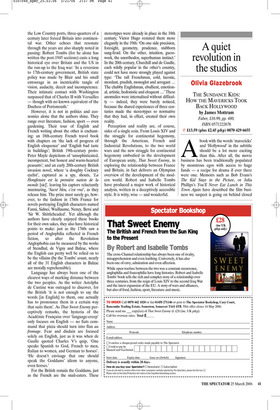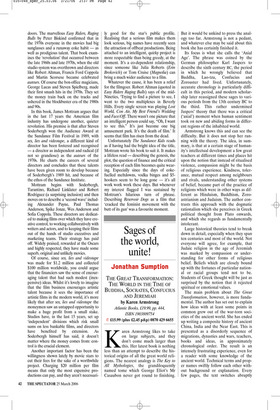A quiet revolution in the studios
Olivia Glazebrook
THE SUNDANCE KIDS: HOW THE MAVERICKS TOOK BACK HOLLYWOOD by James Mottram Faber, ┬Ż16.99, pp. 480, ISBN 0571222676 Ō£å ┬Ż13.59 (plus ┬Ż2.45 p&p) 0870 429 6655 Abook with the words ŌĆśmavericksŌĆÖ and ŌĆśHollywoodŌĆÖ in the subtitle should be a lot more exciting than this. After all, the movie business has been traditionally populated by monstrous egos with access to huge funds ŌĆö a recipe for drama if ever there were one. Memoirs such as Bob EvansŌĆÖs The Kid Stays in the Picture, or Julia PhillipsŌĆÖs YouŌĆÖll Never Eat Lunch in This Town Again have described the film business we suspect is going on behind closed doors. The marvellous Easy Riders, Raging Bulls by Peter Biskind confirmed that in the 1970s everyone in the movies had big sunglasses and a runaway coke habit ŌĆö as well as prodigious talent. That book examines the ŌĆśrevolutionŌĆÖ that occurred between the late 1960s and late 1970s, when the old studio system was overthrown and directors like Robert Altman, Francis Ford Coppola and Martin Scorsese became celebrated auteurs. Of course the box-office magicians, George Lucas and Steven Spielberg, made their first smash hits in the 1970s. They set the money train back on the tracks and ushered in the blockbuster era of the 1980s and 90s.
In this book, James Mottram argues that in the last 17 years the American film industry has undergone another, quieter revolution. His premise is that after Steven Soderbergh won the Audience Award at the Sundance Film Festival in 1989, with sex, lies and videotape, a different kind of director has been fostered and recognised ŌĆö a director as independent and radical (if not so grandiose) as the auteurs of the 1970s. He charts the careers of several directors and concludes that these talents have been given room to develop because of SoderberghŌĆÖs 1989 hit, and because of the ethos of the Sundance Institute.
Mottram begins with Soderbergh, Tarantino, Richard Linklater and Robert Rodriguez (a surprising inclusion) and then moves on to describe a ŌĆśsecond waveŌĆÖ including Alexander Payne, Paul Thomas Anderson, Spike Jonze, Wes Anderson and Sofia Coppola. These directors are dedicated to making films over which they have creative control, to working collaboratively with writers and actors, and to keeping their films out of the hands of studio executives and marketing teams. Their strategy has paid off. Widely praised, rewarded at the Oscars and highly respected, they have made some superb, original and unlikely movies.
Of course, since sex, lies and videotape was made for $1.2 million and collected $100 million worldwide, you could argue that the financiers saw the sense of encouraging talent that had such modest (inexpensive) ideas. Whilst itŌĆÖs lovely to imagine that the film business encourages artistic talent because it sees the importance of artistic films in the modern world, itŌĆÖs more likely that after sex, lies and videotape the moneymen saw an untapped opportunity to make a huge profit from a small stake. Studios have, in the last 15 years, set up ŌĆśindependentŌĆÖ divisions which risk small sums on less bankable films, and directors have benefited by extension. As Soderbergh himself has said, it doesnŌĆÖt matter where the money comes from: control is the crucial element.
Another important factor has been the willingness shown lately by movie stars to cut their fees for the sake of a worthwhile project. Charging $20 million per film means that only the most expensive productions can pay, and they arenŌĆÖt necessari ly good for the starŌĆÖs public profile. Realising that a serious film makes them look serious, big names have recently seen the attraction of offbeat productions. Being attached to an intelligent, quirky project is more respectable than being greedy, at the moment. ItŌĆÖs a co-dependent relationship, since someone like Julia Roberts (Erin Brokovich) or Tom Cruise (Magnolia) can bring a much wider audience to a film.
Whatever the cause, it has been a relief for the filmgoer. Robert Altman (quoted in Easy Riders Raging Bulls) says of the midNineties, ŌĆśTrying to find a picture to see, I went to the two multiplexes in Beverly Hills. Every single screen was playing Lost World, Con Air, My Best FriendŌĆÖs Wedding and Face/Off. There wasnŌĆÖt one picture that an intelligent person could say, ŌĆ£Oh, I want to see this.ŌĆØ ItŌĆÖs just become one big amusement park. ItŌĆÖs the death of film.ŌĆÖ It seems that film has risen from the dead.
Unfortunately The Sundance Kids reads as if having had the bright idea of the title, Mottram wrote his book to suit it. It makes a lifeless read ŌĆö describing the genesis, the plot, the question of finance and the critical reception of each film becomes quite wearing. Especially since the days of cokefuelled meltdowns, vodka binges and $5hookers seem to be long gone ŌĆö itŌĆÖs all work work work these days. But whenever my interest flagged I was sustained by MottramŌĆÖs hilarious turn of phrase. Describing Reservoir Dogs as a film that ŌĆścracked the feminist movement with the butt of its gunŌĆÖ was a favourite moment.
























































 Previous page
Previous page